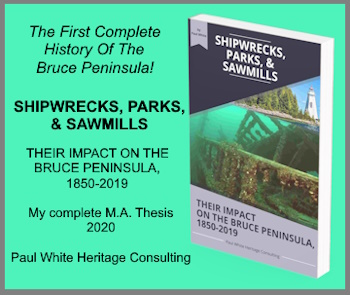Ships Stuck in Ice:
The Oak Glen
Ships Stuck in Ice: The Oak Glen was icebound in 1996 but this sailing hazard has been impacting vessels on Georgian Bay since the beginning of time.
Recently I joined the many spectators who lined the roadway and shoreline near Pyette Point watching the Oak Glen struggle to free itself from the ice which packed the waters of Owen Sound.
I watched with amazement as a smaller vessel, an American ice breaker, made its way through the ice with relatively very little difficulty to free the considerably larger vessel.
This was not the first time that a vessel in distress had been helped by another ship, nor was it the first time that a ship stuck in ice required rescuing.
In an earlier column (July 23/94), I detailed the story of the Prince Alfred which was stranded in Tobermory in 1880 and, later on the same voyage, it was again a prisoner of an ice flow which carried it past its home port of Wiarton to a position south of Griffith Island. The Prince Alfred's captain, Andrew Port, walked across the ice to Big Bay and sent a message to his family that he was safe. After returning to his ship, he was able to make it into port.
In 1941, the Secord become trapped in the ice near Presque Isle. While waiting for assistance, some of the crew members climbed down from the vessel to the ice and walked ashore. They made their way to the general store at East Linton. The reason that they braved walking on the treacherous ice was not to inform friends and loved ones of their safety — but rather to buy cigarettes!
Unlike the Oak Glen, the Secord did not escape its icy prison unscathed. She was towed back to Owen Sound harbour to have her tail shaft repaired. As it was rather a large vessel the machinists at Wm. Kennedy and Sons, where the damage was mended, needed to improvise in order to quickly get the ship back into service.
Two large lathes were positioned in such a manner that the tail shaft could be placed into both lathes at the same time to ensure that it would be perfectly functional after it was machined and reinstalled on the vessel.
A century earlier, in almost the same location where the Secord was trapped in ice, the first ship to call Owen Sound its home port, the Fly, ran aground at Presque Isle.
As there were no other vessels to free it, the first settlers of this community took matters into their own hands.
Working frantically to save the vessel which was their life line to the outside world, they waded into the chilly autumn water, and despite driving winds, rain and snow, they were able to lighten the Fly's load. Once this was accomplished, they managed to free the vessel from its grounding and save it from being driven ashore and wrecked.
Ships have always tried to assist their sister vessels whether they were ships stuck in ice, or otherwise. In the first week of September 1879, not far from where the Oak Glen was stranded nearly 120 years later, the steam barge Vanderbilt was disabled off Griffith Island on a voyage from Midland to Goderich.
The Prince Alfred steamed out of its port at Wiarton to assist the vessel which was laden with lumber and lath. Unfortunately for the Prince Alfred, it was over-matched due to size and weight of the Vanderbilt.
The Prince Alfred broke its rudder and screw. Now two vessels lay disabled in the water, helpless against whatever the waters and winds of Georgian Bay might conjure up. Fortunately, the steamer, Northern Belle, was passing nearby, and saw the distress signals sent up by the two injured vessels. The Northern Belle towed both vessels to Owen Sound for repairs and both were soon back in service.
The recent events this spring in the water of Owen Sound once again remind us that, in spite of modern technology, the ships which sail the Great Lakes are still vulnerable to the same forces of nature which played havoc on maritime travel a century ago.
A version of this story first appeared in my Local History column in the Owen Sound Sun Times on April 27, 1996.
Georgian Bay Shipping
List of Lighthouses on the Great Lakes: If you have names and/or pictures of Great Lakes Lighthouses please submit them along with details of their location.
Georgian Bay Ships: A List of all the ships that sailed on Georgian Bay until the 1960s. This list is not complete. If you know of a ship that sailed the waters of Georgian Bay please contact me with information about that vessel, and, if you have a picture that I could post with it, that would be much appreciated.
1885: A Memorable Summer Job for Owen Sound teenage boys on the Great Lakes would have historic importance, not mention a possible exciting career opportunity.
Hindman Transportation Company was a well-known Great Lakes shipping company for many years. Here you will find pictures of many of the Hindman ships
Owen Sound Harbour – A Photographic History, by Robert A. Cotton is a book that interests my historiographical curiosity.
Commercial Great Lakes Fishing It is probably safe to suggest that the commercial fishing industry was an important part of the early growth of this region.
A Georgian Bay fishing vacation has long been a popular attraction in the Bruce Peninsula region. During fishing derbies, the regional waterways are dotted with fishing boats of all shapes and sizes.
The Georgian Bay Mackinaw, designed by William Watts of Collingwood is an example of a Georgian Bay innovator creating a vessel to service the needs local mariners.
Great Lakes fishing is an asset that is protected and developed, not only for its economic potential but also for those who just enjoy spending a day by the side of a river or in small fishing boats trying to catch “the big one”!
Great Lakes Fishing History is not without its controversy. The impact of the fishing industry was such that it played an important role in the development of communities along the Georgian Bay and Lake Huron shoreline.
Georgian Bay Travel Before the Winter Freeze-Up could be a dangerous time for mariners in the early years in this region.
A Harbinger of Spring on the Great Lakes in pioneer times, was the eagerly awaited news that a lighthouse had been lit and shipping traffic could begin sailing from port to port.
Lumber Hookers Lumber hookers and tugs were an important innovation to improve the transportation of lumber on Georgian Bay.
Mapmakers on Georgian Bay were also explorers. They mapped the Georgina Bay shoreline noting safe harbours, dangerous reefs and other guides for sailors and pioneer settlers looking for a place to call home.
Paddling Georgian Bay & Pondering: traversing parts of this great waterway in a canoe leads one to wonder about the ships of a bygone era battling the rough seas they encountered.
Parry Sound Shipping History: The Parry Sound area has always been connected to the southern regions of the Province of Ontario by a system of good roads. Or has it?
Parry Sound’s shipping history 2 is more than the tragic sinking of the Waubuno or the later catastrophe surrounding the sinking of the Asia.
Sailing Season Closing: A Frantic Time on Peninsula as ships raced from port to port delivering and picking up passengers and produce before the waterways froze.
Ship Captain Andrew Port was not only a dynamic and brave Georgian Bay mariner, he was a personal favourite historical character of mine.
Ships Stuck in Ice: The Oak Glen was icebound in 1996 but this sailing hazard has been impacting vessels on Georgian Bay since the beginning of time.
Lake Huron shipwrecks, the Hibou often occurred in the Georgian Bay region of that Great Lake due to the often violent waters that could strike unsuspecting vessels like the Hibou.
Shipwrecks: The "Asia" wrecked off the eastern coast of Georgian Bay taking all but two of the more than 100 passengers to a watery grave.
Masters, Mates, and Pilots Association created its first Canadian chapter on Georgian Bay, providing maritime safety education, and other seafaring issues to better inform its membership.
Pioneer Travel Aboard the Fly Tells the story of a sailing vessel as the tenuous link between survival and death in a pioneer settlement in the 1840's in Upper Canada.
Sailing Stories: the Captain Who Smelled his way into Port The Captain Who Smelled his Way into Port details how pioneer seamen on Georgian Bay safely sailed the rough waters without the aid of the modern technological tools so readily used by today's mariners.
Sailing Story: The Voyage of the Prince Alfred the incredible voyage of the Prince Alfred, fraught with danger for both vessel and the crew in the winter of 1880.
Shipbuilding As the southern Georgian Bay region became more populated shipping traffic increased to meet the needs of an expanding market place.
The Summer of 1844 was No Picnic for the early settlers in the pioneer area near what would become Owen Sound on Georgian Bay.
The CPR Grain Elevator Fire of 1911 spelled the end of Owen Sound's role as the eastern terminus of the CPR Great Lakes Fleet.
Georgian Bay shipping occurred long before the first Europeans paddled these waters. But the fur and timber trades opened Georgian Bay to shipping in a big way!





